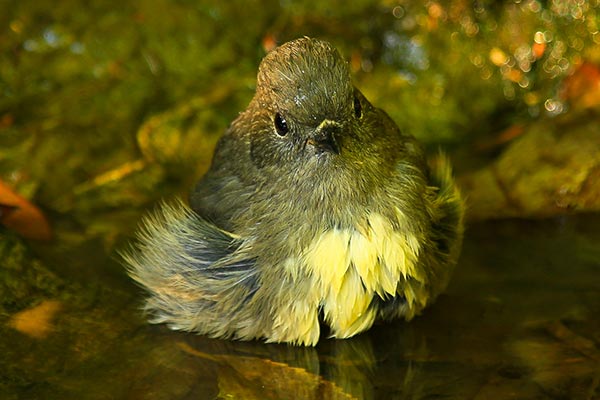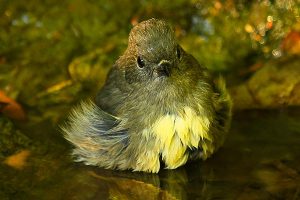South Island Robin

South Island Robin
Petroica australis (Sparrman, 1788)
Order: Passeriformes
Family: Petroicidae
New Zealand status: Endemic
Conservation status: Declining
Other names: New Zealand robin, kakaruwai, kakaruai, kakariwai, toutouwai, bush robin
Geographical variation: Two subspecies are recognised: South Island robin P. a. australis (Not Threatened); Stewart Island robin P. a. rakiura (At Risk / Recovering)
The adult male South Island robin is dark grey-black over the head, neck, mantle and upper chest; the flight feathers and tail are brownish-black, and the lower chest and belly white to yellowish white with a sharp demarcation between black and white on chest. Adult females are light to dark grey over the upper body. They further differ from males in the white chest-belly area being smaller and not having such a distinct demarcation between grey and white feathering. Juveniles are similar to females, but often with a smaller or no white patch on the underparts. Adults of both sexes are able to expose a small white spot of feathers above the base of the beak during intraspecific and interspecific interactions.
Identification
The adult male South Island robin is dark grey-black over the head, neck, mantle and upper chest; the flight feathers and tail are brownish-black, and the lower chest and belly white to yellowish white with a sharp demarcation between black and white on chest. Adult females are light to dark grey over the upper body. They further differ from males in the white chest-belly area being smaller and not having such a distinct demarcation between grey and white feathering. Juveniles are similar to females, but often with a smaller or no white patch on the underparts. Adults of both sexes are able to expose a small white spot of feathers above the base of the beak during intraspecific and interspecific interactions.
Voice: South Island robins have four recognisable vocalisations. Fullsong is a series of phrases given loudly by males only, generally from a high perch. Robins can be heard giving fullsong year round, but particularly during the breeding season. It is used to indicate territorial occupancy and to attract a mate – bachelors spend much more time singing than paired males. Subsong is similar to fullsong but given at much less volume, is given by both sexes, and most frequently during the moult. The downscale is a series of very loud ‘chuck’ calls, descending in tone, and which start in rapid succession and finish slowly. The call lasts 3-4 seconds, is given by both sexes, and is most frequently heard during the non-breeding season (January-June). The fourth vocalisation type is the ‘chuck’, which is given as single notes (contact calls) or in rapid succession and loudly (as an alarm call) when a predator is nearby.
Similar species: there are no species that are similar to the robin in the South Island or Stewart Island. Robins are much larger and lack the white wing-bars of tomtits.

Distribution
The South Island robin has a disjunct distribution through both the South and Stewart Islands. Its strongholds in the South Island are Marlborough, Nelson, West Coast as far south as about Harihari, and through Fiordland, with outliers at Jackson Bay and Dunedin. A comparison of the Ornithological Society of New Zealand’s atlas scheme results of 1969-79 and 1999-2004 suggest that the South Island robin’s distribution has changed little during the 20 year interval. Several populations, particularly on islands, have been established by translocations.
Habitat
Robins occur in mature forest, scrub, and exotic plantations, particularly those that are fairly mature with an open understorey. They seem to favour moist areas where there is an open understorey under a closed canopy on fertile soils. Habitats that tend to be shunned are those with widely scattered trees and where the ground is covered by grasses or sparse vegetation on stony, droughty soils.
Population
South Island robin is patchily distributed through its range, and is absent from some seemingly suitable areas while common in others. Pairs have territories of 1-5 ha on the mainland, although populations on pest-free islands can occur at much greater densities (0.2-0.6 ha / pair).
Threats and conservation
While forest clearance for farmland during the 19th and 20th centuries resulted in loss of habitat for the South Island robin, today the main threat to its conservation is predation by introduced mammalian predators, such as feral cats, stoats, possums and ship rats. Eggs, nestlings and adult females (which carry out all incubation and brooding of young) are frequently taken during the breeding season where predators are not controlled. As a result populations become male biased. Where pest control is carried out, populations increase rapidly, and the sex ratio returns to almost 1:1 within a few years – there are usually a few more males than females.
Breeding
South Island robins start nesting in July, with the last clutches laid in December. The female builds the nest while her mate brings her food 2-3 times per hour. Only females incubate the 2-4 eggs; her mate calls her from the nest every 20 minutes or so to provide her with food. Both parents feed the nestlings. Nestlings leave the nest when about 3 weeks old, and continue to be fed by their parents for a further 5-6 weeks. If one fledgling is reared the male feeds it while the female builds a nest and incubates the next clutch. If there are two fledglings, each is usually fed by a different parent, and if three the male usually looks after two and the female one.
Behaviour and ecology
Male robins are territorial year round, although their aggression towards intruders is subdued during the moult. Pairs remain in their territories most of the time, occasionally sneaking elsewhere to feed, drink or bathe. Males dominate their mates during the non-breeding season, such that pair members are occasionally found apart.
Robins use a variety of activities to flush hidden or camouflaged prey, such as foot trembling, wing-flicking and tail-flicking. Occasionally they capture relatively large prey, which are killed, dismembered, and some portions are often cached. These are usually retrieved later the same day or the following one. Other activities of South Island robins include anting, sunbathing and pellet casting.
Food
While robins spend much time foraging on the ground, they also scan from perches for prey. Much of their diet consists of invertebrates, and large prey items include earthworms, cicadas, stick insects, tree weta and slugs. Slugs are wiped on the ground from side to side, presumably to get rid of slim, before being eaten. Robins also eat small ripe fruit in summer and autumn, particularly during drought when few soil-dwelling invertebrates are available.

 Relax in the knowledge that you’ll be with the only NZ operator that guarantees you will not get seasick.
Relax in the knowledge that you’ll be with the only NZ operator that guarantees you will not get seasick.